When It's Essential to Address a Broken Faucet
When It's Essential to Address a Broken Faucet
Blog Article
We've found this article pertaining to Why Are My Faucets Dripping (And Can I Fix It Myself)? listed below on the net and think it made perfect sense to quickly share it with you over here.

Trickling faucets may seem like a minor trouble, but their effect exceeds simply the annoyance of the noise. From drainage to incurring unnecessary monetary expenses and wellness threats, ignoring a leaking faucet can cause numerous effects. In this write-up, we'll look into why it's crucial to address this common house issue promptly and effectively.
Wastage of Water
Ecological Influence
Trickling taps contribute considerably to water wastage. According to the Environmental Protection Agency (EPA), a solitary tap leaking at one drip per second can throw away greater than 3,000 gallons of water annually. This not only pressures water resources but additionally impacts communities and wild animals based on them.
Financial Costs
Raised Water Expenses
Past the ecological impact, trickling faucets can blow up water costs substantially. The gathered wastage gradually converts into higher energy expenses, which can have been stayed clear of with prompt fixings.
Potential Home Damages
Furthermore, extended dripping can lead to harm to fixtures and surfaces bordering the tap. Water accumulation can trigger staining, deterioration, and even architectural problems if left unattended, causing additional fixing expenses.
Health and wellness Concerns
Mold And Mildew and Mold Growth
The consistent presence of wetness from a trickling faucet produces a perfect atmosphere for mold and mildew and mold development. These fungis not just compromise indoor air high quality however additionally posture health risks, especially for people with respiratory conditions or allergies.
Waterborne Diseases
Stagnant water in dripping taps can come to be a breeding place for microorganisms and various other microorganisms, boosting the danger of waterborne conditions. Pollutants such as Legionella bacteria thrive in stationary water, potentially causing serious ailments when ingested or inhaled.
Do it yourself vs. Specialist Repair
Pros and Cons of DIY Fixing
While some may attempt to take care of a trickling faucet themselves, DIY repair services feature their own set of difficulties. Without appropriate expertise and devices, DIY attempts can worsen the issue or lead to insufficient repairs, prolonging the issue.
Benefits of Employing an Expert Plumber
Employing a professional plumber makes certain that the underlying reason for the trickling faucet is attended to properly. Plumbings possess the competence and tools to identify and repair faucet concerns successfully, conserving time and lessening the danger of further damage.
Step-by-Step Overview to Taking Care Of a Dripping Faucet
Tools Called for
Prior to attempting to fix a dripping tap, collect the necessary devices, including an adjustable wrench, screwdrivers, substitute parts (such as washing machines or cartridges), and plumber's tape.
Common Tap Issues and Their Solutions
Determine the sort of faucet and the specific concern causing the drip. Typical troubles include damaged washers, corroded shutoff seats, or faulty O-rings. Describe supplier instructions or on the internet tutorials for detailed advice on repair services.
Preventive Measures
Normal Maintenance Tips
To stop leaking taps, execute regular upkeep such as cleaning aerators, inspecting for leaks, and replacing worn-out parts quickly. Furthermore, think about setting up water-saving gadgets or upgrading to more efficient components.
Relevance of Prompt Services
Resolving trickling faucets as soon as they're noticed protects against additional water waste and prospective damage, inevitably conserving both water and money in the future.
Effect On Building Value
Perception of Well-Maintained Building
Preserving a home in good condition, including attending to maintenance problems like leaking faucets, boosts its viewed value and charm amongst potential customers or renters.
Impact on Resale Worth
Qualities with well-maintained plumbing fixtures, consisting of taps, command greater resale values in the real estate market. Resolving dripping faucets can contribute to a positive impact during residential property assessments and arrangements.
Environmental Duty
Individual Payment to Preservation
Taking duty for repairing dripping faucets aligns with wider efforts toward water preservation and ecological sustainability. Every individual's activities collectively make a substantial effect on preserving valuable resources.
Sustainable Living Practices
By focusing on timely repair services and embracing water-saving behaviors, people contribute to lasting living methods that benefit both existing and future generations.
Conclusion
Addressing a leaking faucet surpasses mere ease; it's a necessary step towards conserving water, reducing economic costs, and securing health and building. Whether through do it yourself fixings or professional help, doing something about it to repair leaking taps is a small yet impactful way to advertise responsible stewardship of resources and contribute to a healthier, a lot more lasting future.
How to Fix a Dripping or Leaky Faucet
A leaking faucet is one of the most common problems that homeowners encounter, but it being commonplace doesn’t make it any less annoying. The constant drip drip drip of a leaking bathtub faucet, showerhead, or sink tap can disturb your home’s serenity. Left neglected, a dripping faucet can also result in higher water bills and discoloration or mold growth in your sink or plumbing fixtures.
Fortunately, you don’t have to be a trained plumber to know how to stop a dripping faucet. With some basic tools, replacement parts, and a little patience, leaky faucet repair is a breeze. In this article, we’ll explain what causes dripping faucets and how you can fix them.
What Causes a Leaking Faucet?
Kitchen and bathroom faucets come in all manner of designs, but most involve some combination of valves, O-rings, seals, and washers. The O-ring is usually the weakest link, but any one of these pieces can wear down over time. Heat, moisture, temperature fluctuations, minerals, mold, and movement can contribute to warping and corrosion, breaking the watertight seal. This just comes with the territory of being a homeowner. Everything is always subject to wear and tear, and some component parts of your appliances and fixtures need to be replaced on occasion. At least replacement O-rings are cheap!
More rarely, dripping faucets can be a symptom of excessively high water pressure. Were this the case in your home, you would probably notice that the leak is not isolated to one faucet. Water pressure issues are harder to resolve on your own. We recommend contacting a professional plumber if you suspect your water pressure is too high.
How to Fix a Dripping Faucet
Pipe wrench or monkey wrench Allen wrench set Screwdrivers Old towel or rag Shut off the water.
Before you do anything, you need to turn off the water to keep from drenching your kitchen or bathroom. You should find a valve under the sink and against the wall. Once you’ve turned this valve, try turning the faucet on to confirm that the water source has been cut off.
If you can’t locate your local valve for the faucet you’re working on, you can always shut off the water to the house at the main valve. Of course, this will prohibit anyone from using the sinks, showers, or toilets while you’re working on the faucet that’s giving you trouble.
Plug or block the drain.
You’ll be disassembling the faucet and removing some small bits of hardware. Plug the drain with a stopper or rag to avoid the possibility of a small screw falling into your P-trap.
Take apart the faucet assembly.
There are several varieties of kitchen and bathroom faucets, each with its own manner of assembly. For detailed instructions on how to disassemble your faucet, you can refer to the fixture’s manual or contact the manufacturer. If you know whether you have a ball, disc, cartridge, or compression faucet, you can find detailed schematics online.
In general, you need to begin by removing the faucet handles. You might notice a small screw that you’ll need to remove with a screwdriver or Allen wrench. If you don’t see any visible securing hardware, it’s likely hidden under a decorative cap that can be unscrewed or popped off with flathead screwdriver.
Remove each piece methodically, consulting a schematic when necessary. Take notes or arrange the pieces in such a way to make it easier to correctly reassemble the faucet later.
Remove the cartridge.
Once you’ve removed the handles and securing hardware, you should be able to remove the valve cartridge or stem. Some cartridges will slide right out. Other faucet models will require you to loosen a nut with a pipe wrench before you can remove the valve stem.
Examine the exposed hardware.
With the cartridge or stem removed, inspect the component parts. Check the rubber O-rings for wear and tear. Also examine the seat washer for corrosion or other damage. These pieces are usually the responsible parties for a dripping faucet, but it’s worth inspecting the other component parts while you have the faucet disassembled.
Find replacement parts.
Once you’ve identified which faucet component has failed, find an identical replacement. Your local hardware store should have O-rings, seat washers, and other standard components in stock. If you have a luxury or uncommon faucet, you may have to contact the manufacturer for a replacement part.
It’s a good idea to take your old parts with you to the hardware store so you can compare them with the store’s inventory and be sure you’re purchasing the correct replacement.
Reassemble the faucet.
With your new parts in hand, reconstruct the faucet and handles. Don’t be tempted to overtighten screws or nuts. You might think this could create a better seal, but it can instead damage or bend a delicate part of the assembly and create a new problem for you.
Turn on the water and test the faucet.
The only thing left to do is test your work. Unplug the sink, turn the water back on, and try the faucet. Congratulate yourself on a job well done!
https://www.libertyhomeguard.com/how-to-fix-a-dripping-or-leaky-faucet/

I am very focused on Why Are My Faucets Dripping (And Can I Fix It Myself)? and I am assuming you liked our entry. Do you know someone else who is excited about the niche? Do not hesitate to promote it. Thanks for your time spent reading it.
Report this page